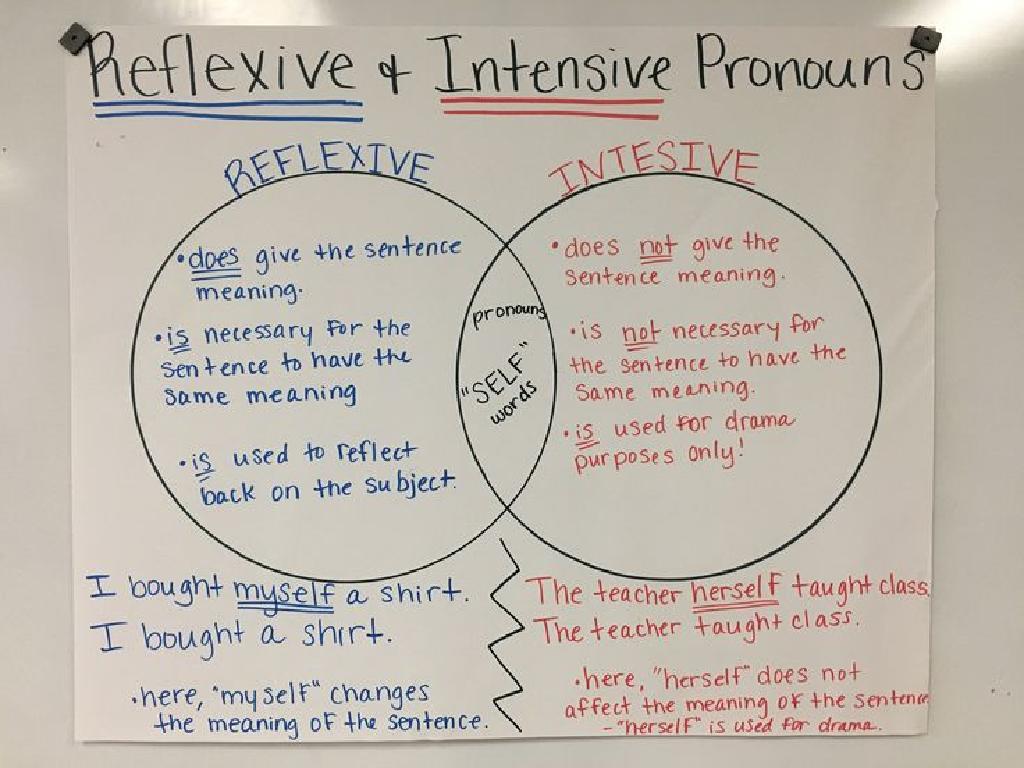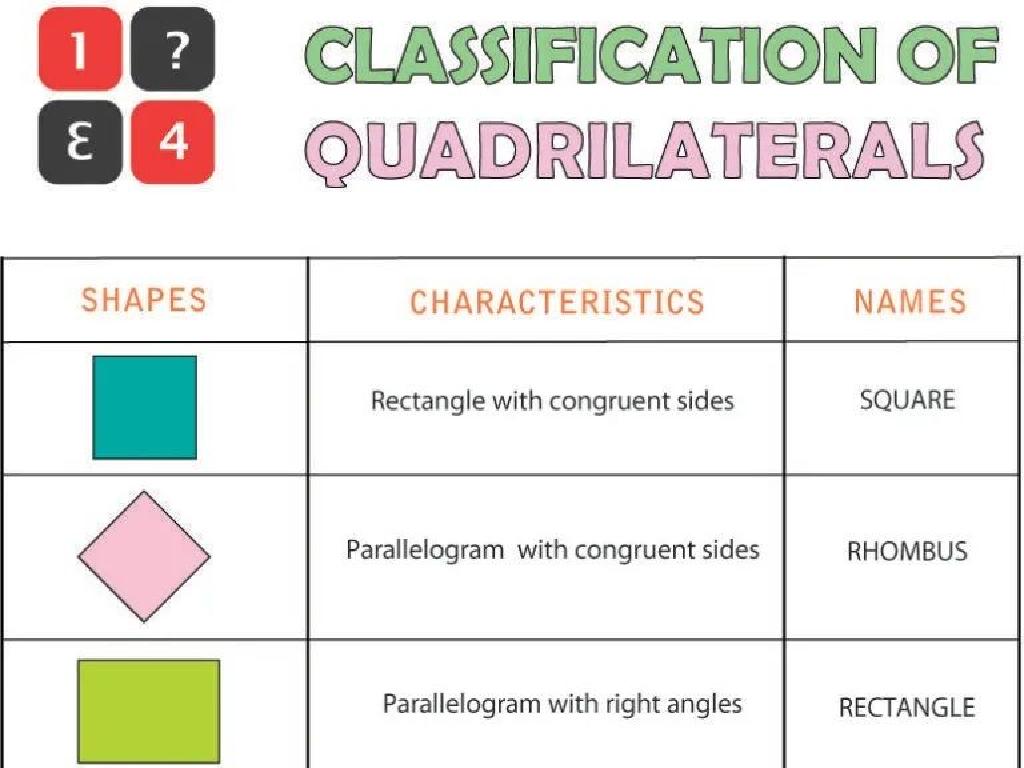Area Of Rectangles With Fractions
Subject: Math
Grade: Fifth grade
Topic: Area
Please LOG IN to download the presentation. Access is available to registered users only.
View More Content
Exploring Area: Rectangles with Fractions
– What is area and its units?
– Area measures the size of a surface, usually in square units like sq. inches.
– Recap: Area of simple rectangles
– Area of a rectangle is found by multiplying length by width (l x w).
– Today’s focus: Fractions in area
– We’ll learn how to include fractions when measuring parts of a rectangle.
– Calculating area with fractional sides
– Example: A rectangle with a length of 4 1/2 feet and width of 3 feet.
|
Begin with a brief explanation of area and its units to ensure students understand the basic concept. Recap the method for finding the area of simple rectangles as a foundation. Shift the focus to rectangles with fractional side lengths, emphasizing that the concept is the same but includes an additional step of working with fractions. Provide examples with fractional lengths and widths, demonstrating how to multiply these to find the area. Encourage students to think of real-life objects that might have fractional dimensions. The goal is to make them comfortable with the idea of fractions in geometry.
Understanding Fractions
– Definition of a fraction
– A fraction represents a part of a whole or a division of a whole into equal parts.
– Fractions in daily life
– Pizza slices, a glass of water, or pieces of a chocolate bar.
– Fractions show part of a whole
– If a pizza is cut into 4 pieces, each piece is a fraction (1/4) of the pizza.
– Visualizing fractions
|
Begin the lesson by explaining that a fraction is a way to represent a part of a whole, using two numbers separated by a slash. The top number (numerator) indicates how many parts we have, while the bottom number (denominator) shows how many equal parts the whole is divided into. Provide relatable examples such as slices of pizza or segments of an orange to illustrate fractions in everyday life. Emphasize that fractions help us understand and communicate precisely how much of something we have. Use visual aids like fraction circles or bars to help students visualize fractions as parts of a whole. This foundational understanding is crucial for learning how to calculate the area of rectangles with fractional side lengths.
Multiplying Fractions
– Steps to multiply fractions
– Multiply the top numbers (numerators), then multiply the bottom numbers (denominators).
– Multiply numerators and denominators
– Multiply across: 1/2 x 2/3 = (1×2)/(2×3).
– Example: Multiply 1/2 by 2/3
– Simplify the result, if possible, to find the area.
– Practice with different fractions
|
This slide introduces the concept of multiplying fractions, which is essential when calculating the area of rectangles with fractional side lengths. Start by explaining the process of multiplying the numerators to get the new numerator and doing the same with the denominators for the new denominator. Use the example of 1/2 multiplied by 2/3 to show this process in action. After simplifying, the result is 1/3, which represents the area of a rectangle with sides 1/2 and 2/3. Encourage students to practice with additional problems, using different fractions to solidify their understanding. Provide guidance on simplifying fractions and remind them that the area is always in square units.
Calculating Area with Fractions
– Area formula: Length x Width
– Identify length and width
– Length is the longer side, width is the shorter side.
– Example with whole numbers
– If a rectangle is 4 units long and 3 units wide, area = 4 x 3 = 12 square units.
– Practice with fractional measurements
– What if the length is 4 1/2 units and the width is 3 1/3 units?
|
This slide introduces the concept of calculating the area of a rectangle when dealing with fractional measurements. Start by reviewing the formula for the area of a rectangle. Ensure students can identify the length and width on various rectangles. Use an example with whole numbers to demonstrate the calculation process. Then, challenge students with an example that includes fractions to apply their understanding of the area formula. Encourage students to convert fractions to improper fractions or decimals if necessary for easier multiplication. Provide additional practice problems with different fractional lengths and widths to solidify their learning.
Area of Rectangles with Fractional Sides
– Rectangles with fractional sides
– A rectangle can have sides that are fractions of a unit.
– Area formula with fractions
– Multiply length by width, even if they’re fractions.
– Example: 1/2 ft by 3/4 ft rectangle
– Area = 1/2 ft * 3/4 ft = 3/8 ft². How did we get this?
|
This slide introduces students to the concept of finding the area of rectangles when the sides are given in fractions. Start by explaining that rectangles can have sides that are not whole numbers but fractions, which is common in real-life scenarios. Show how the area formula (length x width) is still applicable by multiplying the fractional lengths of the sides. Use the example provided to demonstrate the multiplication of fractions in a practical context. Have students practice with additional examples, ensuring they understand how to multiply fractions and simplify the result to find the area.
Practice: Area of Rectangles with Fractions
– Calculate area: 2/5 m by 1/3 m
Area = length x width. What’s 2/5 x 1/3?
– Find area: 3/8 in by 5/6 in
Use multiplication of fractions. What’s 3/8 x 5/6?
– Discuss solutions together
– Learn from common mistakes
We’ll review errors like adding instead of multiplying.
|
This slide is aimed at providing students with practice problems to apply their knowledge of finding the area of rectangles when dealing with fractional measurements. Encourage students to set up the multiplication of fractions correctly and to simplify their answers. During the discussion, highlight the importance of multiplying to find the area, not adding. Address common errors such as incorrect fraction multiplication or forgetting to simplify the answer. Provide step-by-step solutions for each problem and ask students to share their methods. This will reinforce their understanding and help identify any misconceptions.
Class Activity: Create Your Own Rectangle
– Gather materials: paper, scissors, ruler
– Cut rectangles with fractional lengths
Use the ruler to measure and cut sides like 1/2 inch or 3/4 inch.
– Calculate the area of each rectangle
Area = length x width. Remember to multiply fractions.
– Share your findings with the class
|
This hands-on activity is designed to help students understand the concept of area in the context of fractions. Provide each student with construction paper, scissors, and a ruler. Guide them to measure and cut out rectangles with fractional side lengths, such as 1/2 inch by 3/4 inch. Once they have their rectangles, instruct them on how to calculate the area by multiplying the fractional lengths. Emphasize the multiplication of fractions and simplifying the result. After calculations, students will share their rectangles and the calculated areas with the class, fostering a collaborative learning environment. Possible variations for different students could include using different fractional lengths, comparing areas of different rectangles, or even creating complex shapes by combining rectangles.
Wrapping Up: Area with Fractions
– Recap: Area with Fractional Sides
– Real-life Applications of Area
– Area helps in planning spaces, like gardens or rooms.
– Homework: Fractional Area Worksheet
– Solve 5 problems involving area and fractions.
– Practice Makes Perfect!
– Keep practicing to master area calculations!
|
As we conclude today’s lesson, remind students of the method to calculate the area of rectangles when sides are fractions. Emphasize the importance of understanding area in real-world scenarios, such as interior design or agriculture. For homework, students will complete a worksheet with 5 problems to reinforce their learning. Encourage them to approach each problem methodically, drawing diagrams if necessary, and to check their work for accuracy. Remind them that consistent practice is key to mastering the concept of area with fractions.






